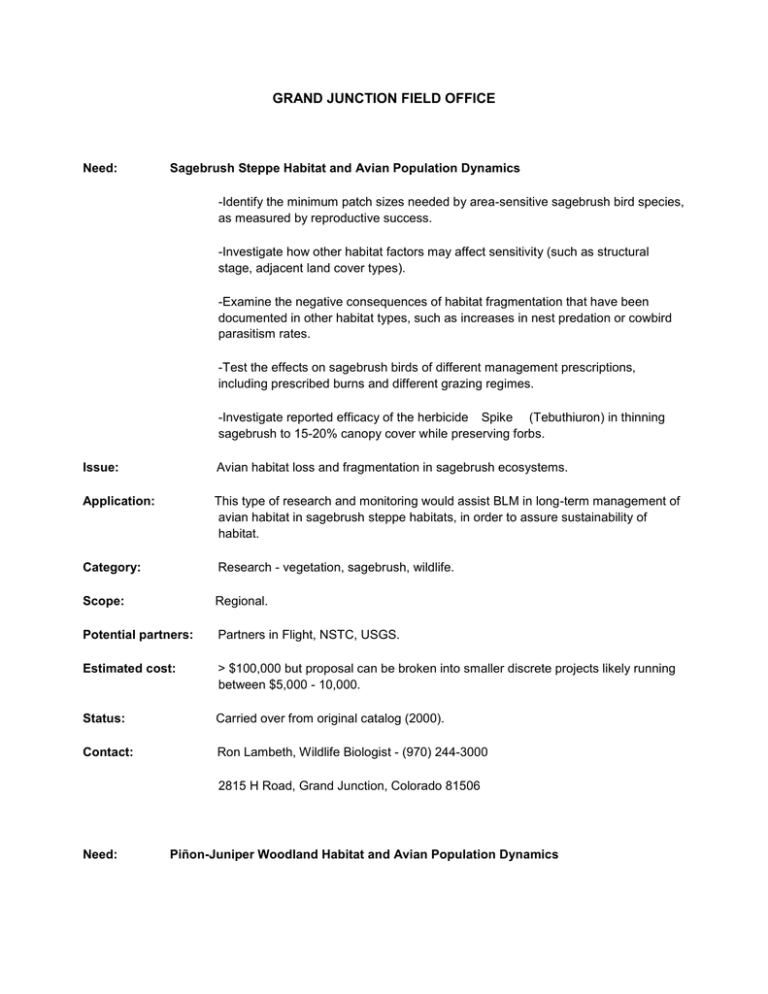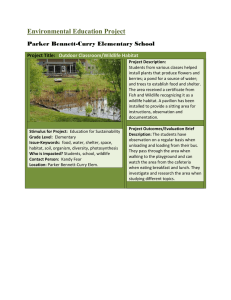Grand Junction
advertisement

GRAND JUNCTION FIELD OFFICE Need: Sagebrush Steppe Habitat and Avian Population Dynamics -Identify the minimum patch sizes needed by area-sensitive sagebrush bird species, as measured by reproductive success. -Investigate how other habitat factors may affect sensitivity (such as structural stage, adjacent land cover types). -Examine the negative consequences of habitat fragmentation that have been documented in other habitat types, such as increases in nest predation or cowbird parasitism rates. -Test the effects on sagebrush birds of different management prescriptions, including prescribed burns and different grazing regimes. -Investigate reported efficacy of the herbicide Spike (Tebuthiuron) in thinning sagebrush to 15-20% canopy cover while preserving forbs. Issue: Avian habitat loss and fragmentation in sagebrush ecosystems. Application: This type of research and monitoring would assist BLM in long-term management of avian habitat in sagebrush steppe habitats, in order to assure sustainability of habitat. Category: Research - vegetation, sagebrush, wildlife. Scope: Regional. Potential partners: Partners in Flight, NSTC, USGS. Estimated cost: > $100,000 but proposal can be broken into smaller discrete projects likely running between $5,000 - 10,000. Status: Carried over from original catalog (2000). Contact: Ron Lambeth, Wildlife Biologist - (970) 244-3000 2815 H Road, Grand Junction, Colorado 81506 Need: Piñon-Juniper Woodland Habitat and Avian Population Dynamics -Research the general natural history of the priority piñon-juniper bird species including: breeding biology, foraging biology (is species important in limiting number of devastating insects in piñon), and habitat requirements. -Determine habitat selection parameters to assess how fuelwood harvest may affect the Black-chinned Hummingbird. -Based on the flower phrenology that sustains the Black-chinned Hummingbird through its Nearctic season: could livestock grazing systems be designed to assure adequate nectar sources through the summer season. Site rehabilitation mixes should have the information that could help to bolster flower species that are needed during the leanest nectar periods. -Determine the effects of cowbird parasitism on Black-chinned Hummingbirds, Gray Flycatchers, Gray Vireos, Juniper Titmice, and Black-throated Gray Warblers. -Determine conditions that lead to excessive parasitism and predation failure in nesting of piñon-juniper birds: vireos, including Gray and Plumbeous, are known to not be able to raise their own young when there's a cowbird chick around, but how likely is this to be threatening to a population? Are nest mites more common in closed canopy than open canopy piñon-juniper, lightly grazed than heavily grazed sites? What level of human presence brings in the jays and drives out the Cooper's Hawks resulting in more nest predation? (This raises a lot of Watchable Wildlife concerns that need studying.) -Test the hypothesis that Gray Vireo habitat can be created by stand thinning. -Research the general natural history of the Juniper Titmouse including: breeding biology (Does the species form permanent pair bonds? Do they defend territories throughout the year?) foraging biology (Is species important in limiting number of devastating insects in piñon?), and habitat requirements. -Determine habitat selection parameters to assess fuelwood harvest effect on Juniper Titmouse. Issue: Piñon-juniper, avian population dynamics. Application: This type of research and monitoring would assist BLM in long-term management of avian habitat in piñon-juniper woodland habitats, in order to assure sustainability of habitat. Category: Research - vegetation, wildlife. Monitoring - vegetation, wildlife. Scope: Regional. Potential partners: Partners in Flight, NSTC, USGS. Estimated cost: > $100,000 but proposal can be broken into smaller discrete projects likely running between $5,000 - 10,000. Status: This issue and need have been incorporated into the BLM Colorado Plateau PiñonJuniper Strategy. NSTC is also providing assistance in bibliographic research. Contact: Ron Lambeth, Wildlife Biologist - (970) 244-3000 2815 H Road, Grand Junction, Colorado 81506 Need: Desert Shrubland Habitat and Avian Population Dynamics -Support the investigation of the herbicide OUST for cheatgrass control. -Study the mortality of desert shrubland bird species in Colorado and on winter ranges. -Determine the feasibility of re-introducing priority species (Loggerhead Shrike, Burrowing Owl) to habitats that appear to have recovered. Issue: Desert shrubland, avian population dynamics, cheatgrass, species re-introduction. Application: This type of research and monitoring would assist BLM in long-term management of avian habitat in desert shrubland habitats, in order to assure sustainability of habitat. Category: Research - vegetation, wildlife. Scope: Regional. Potential partners: Partners in Flight, NSTC, USGS. Estimated cost: > $50,000 but proposal can be broken into smaller discrete projects likely running between. $5,000 - 10,000. Status: Contact: NSTC has included this as a project for the Center which will study the effects of herbicide control on cheatgrass, mortality rates of birds in winter range, and the feasibility of re-introducing priority species to recovered habitat. Ron Lambeth, Wildlife Biologist - (970) 244-3000 2815 H Road, Grand Junction, Colorado 81506 Need: Effect of Percent Slope on Birds in Piñon-Juniper Woodlands Issue: Fuelwood sales and vegetation conversion projects occur most often on relatively level ground. The effect of wildfire last longer on level ground. These events greatly change habitat characteristics of the site for wildlife. The wildlife species that prefer or require late seral piñon-juniper woodland are reduced or eliminated from sites that experience those events. There is a question as to whether there will always be plenty of good piñon-juniper habitat remaining for these species on the steeper ground. Can the relatively level ground be sacrificed to habitat changing uses without impacting populations on a landscape scale? Or are the relatively level, more productive piñon-juniper sites critical to some piñon-juniper obligate species? Currently there are demands to restore mule deer populations West-wide. Piñonjuniper woodland is a popular target for measures to restore deer populations, while gaining livestock forage benefits too. Calls to let wildfires burn in piñon-juniper are becoming stronger. As action on these demands accelerate, studies to determine effects on other wildlife grow more urgent. Application: Environmental assessments on these habitat altering projects without this information must speculate on cumulative effects. To our knowledge, no studies have addressed this question, although some existing studies should help to fill gaps in the information base of this study. Category: Research - vegetation, wildlife. Monitoring - vegetation, wildlife. Scope: Regional. Potential partners: Partners in Flight, NSTC, USGS. Estimated cost: > $50,000 but proposal can be broken into smaller discrete projects likely running between $5,000 - 10,000. Status: This issue and need have been incorporated into the BLM Colorado Plateau PiñonJuniper Strategy. NSTC is also providing assistance in bibliographic research. Contact: Ron Lambeth, Wildlife Biologist - (970) 244-3013 2815 H Road, Grand Junction, Colorado 81506 Need: Effects of Common Fuelwood Harvest Practices on Piñon-Juniper Woodland Birds Issue: The dominant forestry exercised in piñon pines and/or juniper trees is fuelwood sales and to lesser extent postwood sales. Fuelwood harvesting leaves areas in conditions varying according to the sale stipulations and level of compliance. However, several wildlife species are piñon-juniper obligates and other species require a certain density of trees. Sales of wood materials should have advice on stipulation designs. What is the maximum thinning that can occur and still maintain piñon-juniper woodland species? Does this vary with the elevation or some other factor? At what dimension does patch size matter? What is the effect on birds of scattering slash versus piling it? How significant are ips beetle control measures common to forestry practice to woodpeckers, cavity nesters, and other birds? There are informative publications on piñon-juniper conversions on wildlife including birds and there is a good bibliography on birds and forestry practices in other forest types, but we know of no study closely paralleling this proposal in the piñon-juniper zone. Application: Environmental assessments on these habitat altering projects without this information are weak with speculation on the cumulative effects. To our knowledge, no studies have addressed this question, although some studies should help to fill gaps in the information base of this study. Category: Research - vegetation, wildlife. Scope: Regional. Potential partners: Partners in Flight, NSTC, USGS. Estimated cost: > $50,000 but proposal can be broken into smaller discrete projects likely running between $5,000 - 10,000. Status: This issue and need have been incorporated into the BLM Colorado Plateau PiñonJuniper Strategy. NSTC is also providing assistance in bibliographic research. Contact: Ron Lambeth, Wildlife Biologist - (970) 244-3013 2815 H Road, Grand Junction, Colorado 81506






